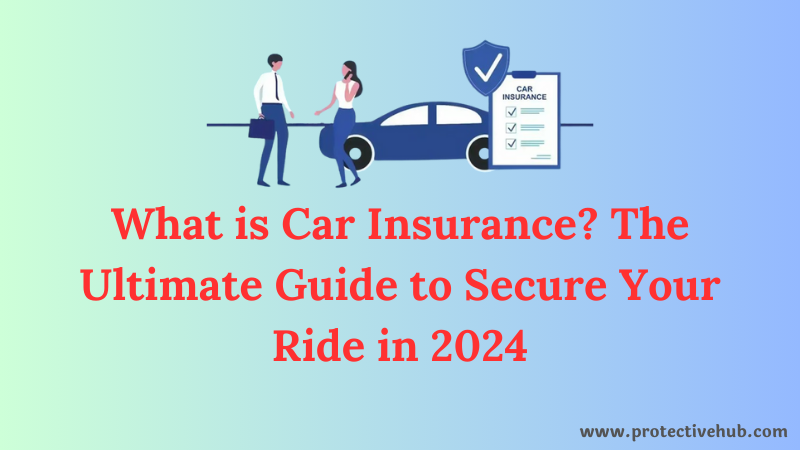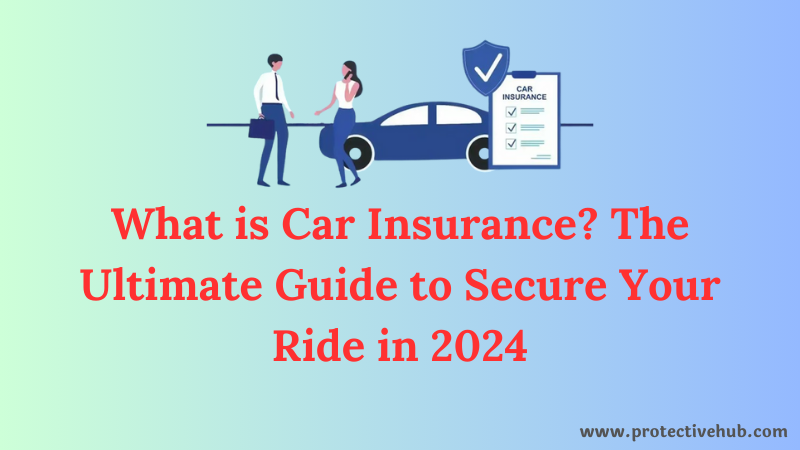Learn everything you need to know about car insurance in this comprehensive guide. Understand the types of coverage, factors affecting premiums, how to choose the right policy, and more. Includes FAQs and debunked myths
Car insurance might seem like a boring and confusing topic, but it’s an essential part of being a responsible car owner. Whether you’re a new driver or have been on the road for years, understanding car insurance can save you money and a lot of headaches down the line. In this comprehensive guide, we’ll break down the ins and outs of car insurance in a simple and straightforward way. Plus, we’ll throw in a dash of humor to keep things light and engaging. By the end of this article, you’ll know everything you need to make informed decisions about your car insurance.

What is Car Insurance?
Car insurance is a contract between you and an insurance company that protects you against financial loss in the event of an accident or theft. In exchange for your premium payments, the insurance company agrees to pay your losses as outlined in your policy. Think of it as a financial safety net for your car.
Fun Fact: Did you know that the concept of car insurance dates back to 1897? Sir Herbert Stanley Hodge purchased the first car insurance policy in the UK for a vehicle. So, car insurance has been around for over a century, and it’s evolved quite a bit since then.
Types of Car Insurance Coverage
There are several types of car insurance coverage, each serving a different purpose. Understanding these types can help you choose the best policy for your needs.
1. Liability Coverage
Liability coverage is the most basic type of car insurance and is required in most states. It covers the costs if you’re responsible for an accident that causes injury or property damage to others. It’s like saying, “Oops, my bad!” and having someone else pay for it.
Important Note: Liability coverage doesn’t cover your injuries or damage to your vehicle.
2. Collision Coverage
Collision coverage pays for damage to your car resulting from a collision with another vehicle or object, like a tree or a pole. If you’re a bit of a klutz behind the wheel, this is the coverage for you.
3. Comprehensive Coverage
Comprehensive coverage is like the Swiss Army knife of car insurance. It covers damage to your car caused by events other than collisions, such as theft, vandalism, fire, natural disasters, and even hitting a deer. Basically, if your car gets hurt and it wasn’t your fault, comprehensive coverage has got your back.
4. Personal Injury Protection (PIP)
PIP, also known as no-fault insurance, covers medical expenses and sometimes lost wages and other damages for you and your passengers, regardless of who is at fault in an accident. It’s like having a personal health insurance plan just for your car.
5. Uninsured/Underinsured Motorist Coverage
This type of coverage comes in handy if you’re in an accident with someone who doesn’t have insurance or doesn’t have enough insurance to cover the damages. It’s like carrying an extra umbrella just in case the other person forgot theirs.
6. Gap Insurance
If you’re financing or leasing your car, gap insurance is a must-have. It covers the difference between what you owe on your car and its actual cash value if it’s totaled in an accident. Think of it as a financial safety net for your car loan.
How Car Insurance Premiums are Determined
Your car insurance premium is the amount you pay for your insurance policy. Several factors influence how much you’ll pay, and understanding these can help you potentially lower your premium.
1. Age and Gender
Younger drivers, especially teenagers, tend to pay higher premiums because they’re considered high-risk. Similarly, male drivers often pay more than female drivers because statistics show they’re more likely to be involved in accidents. So, if you’re a young male driver, you might want to start saving now.
2. Driving Record
Your driving record is one of the most significant factors in determining your premium. If you have a history of accidents or traffic violations, you’ll likely pay more for insurance. On the other hand, a clean driving record can help you score a lower premium.
Tip: Drive safely and avoid speeding tickets. Not only will it keep your premiums down, but it’ll also keep you out of trouble with the law.
3. Location
Where you live plays a big role in how much you’ll pay for car insurance. Urban areas with high traffic and crime rates generally have higher premiums than rural areas. So, if you’re thinking about moving to the big city, consider the impact on your car insurance.
4. Type of Car
The make, model, and year of your car also affect your premium. Expensive cars and those with high repair costs usually come with higher premiums. Additionally, cars with high theft rates can also cost more to insure.
Fun Fact: Red cars don’t actually cost more to insure. It’s a common myth, but insurance companies don’t care about the color of your car.
5. Credit Score
In many states, your credit score can impact your car insurance premium. Insurers believe that drivers with higher credit scores are less likely to file claims, so they offer them lower rates.
Pro Tip: Work on improving your credit score. It can save you money on car insurance and other types of insurance, loans, and credit cards.
Discounts on Car Insurance
Everyone loves a good discount, and car insurance is no different. Here are some common discounts that can help you save on your premium.
1. Safe Driver Discount
If you have a clean driving record with no accidents or violations, you may qualify for a safe driver discount. It’s like getting a gold star for being a responsible driver.
2. Good Student Discount
If you’re a student with good grades, many insurance companies offer discounts. It’s their way of saying, “Keep up the good work!” and rewarding you for your academic achievements.
3. Multi-Policy Discount
Bundling your car insurance with other types of insurance, like home or renters insurance, can earn you a discount. It’s like getting a combo meal at your favorite fast-food joint – you get more for less.
4. Anti-Theft Device Discount
Installing anti-theft devices in your car can lower your premium. Insurance companies like knowing your car is less likely to be stolen, so they reward you with a discount.
5. Low Mileage Discount
If you don’t drive much, you might qualify for a low mileage discount. Insurance companies figure that the less you’re on the road, the less likely you are to get into an accident.
6. Defensive Driving Course Discount
Completing a defensive driving course can earn you a discount on your premium. Plus, it’s a great way to brush up on your driving skills and stay safe on the road.
How to Choose the Right Car Insurance Policy
Choosing the right car insurance policy can be overwhelming, but it doesn’t have to be. Here are some tips to help you make the best decision for your needs.
1. Assess Your Needs
Start by determining what types of coverage you need. Consider factors like your car’s value, how much you drive, and your financial situation. If you have an older car, you might not need comprehensive coverage, but if you have a new, expensive car, it’s a good idea to have full coverage.
2. Compare Quotes
Get quotes from multiple insurance companies to compare prices and coverage options. This will help you find the best deal for your needs. Remember, the cheapest policy isn’t always the best – make sure it offers the coverage you need.
3. Check the Insurer’s Reputation
Research the insurance company’s reputation by reading reviews and checking their ratings with organizations like the Better Business Bureau and J.D. Power. You want to choose a company that has a good track record of customer service and claims handling.
4. Ask About Discounts
Don’t be shy about asking for discounts. Many insurers offer discounts that aren’t advertised, so it’s worth asking if you qualify for any.
5. Read the Fine Print
Before signing on the dotted line, read the policy carefully. Make sure you understand what’s covered and what’s not, and ask questions if anything is unclear.
Common Car Insurance Myths Debunked
There are many myths and misconceptions about car insurance that can lead to confusion. Let’s debunk some of the most common ones.
Myth 1: Red Cars Cost More to Insure
As mentioned earlier, the color of your car doesn’t affect your insurance premium. Insurers care about the make, model, year, and safety features of your car, not its color.
Myth 2: Older Drivers Pay More for Car Insurance
While it’s true that young drivers often pay more for car insurance, older drivers typically enjoy lower premiums. However, premiums can start to increase again for drivers over the age of 65.
Myth 3: Your Credit Score Doesn’t Affect Your Premium
In many states, your credit score does affect your car insurance premium. Insurers believe that drivers with higher credit scores are less likely to file claims, so they offer them lower rates.
Myth 4: Your Insurance Covers You No Matter Who’s Driving
Your car insurance policy generally covers you and other drivers listed on your policy. However, if someone not listed on your policy drives your car and gets into an accident, your insurance may not cover the damages.
Myth 5: Comprehensive Coverage Covers Everything
Despite its name, comprehensive coverage doesn’t cover everything. It covers non-collision-related damages, but it doesn’t cover collision damages, wear and tear, or mechanical breakdowns.
FAQs About Car Insurance
Q1: Do I need car insurance if I don’t drive very often?
A1: Yes, you still need car insurance even if you don’t drive often. Accidents can happen at any time, and having insurance ensures you’re covered. Plus, most states require a minimum amount of liability coverage by law.
Q2: Can I drive someone else’s car if I don’t have insurance?
A2: If you don’t have your own car insurance, you may still be covered by the car owner’s insurance policy. However, it’s important to check with the owner and their insurance company to make sure you’re covered before driving their car.
Q3: What should I do if I can’t afford my car insurance premium?
A3: If you’re struggling to afford your car insurance premium, contact your insurance company to discuss your options. They may be able to adjust your coverage or offer a payment plan. Additionally, you can shop around for a more affordable policy.
Q4: How do I file a car insurance claim?
A4: To file a car insurance claim, contact your insurance company as soon as possible after the incident. Provide them with all the necessary information, such as the date and time of the incident, a description of what happened, and any photos or documents that can support your claim. The insurance company will guide you through the process and let you know what to expect.
Q5: Will my premium go up if I file a claim?
A5: Filing a claim can cause your premium to increase, especially if you’re at fault for the accident. However, some insurance companies offer accident forgiveness programs that prevent your premium from increasing after your first accident.
Conclusion
Car insurance might not be the most exciting topic, but it’s an important one. By understanding the different types of coverage, how premiums are determined, and how to choose the right policy, you can make informed decisions that protect you and your wallet. Remember to take advantage of discounts, debunk common myths, and ask questions if you’re unsure about anything. With the right car insurance policy, you can drive with peace of mind knowing you’re covered in case of an accident or other unexpected events.
